Cockatoo Island Penal Establishment
Sydney
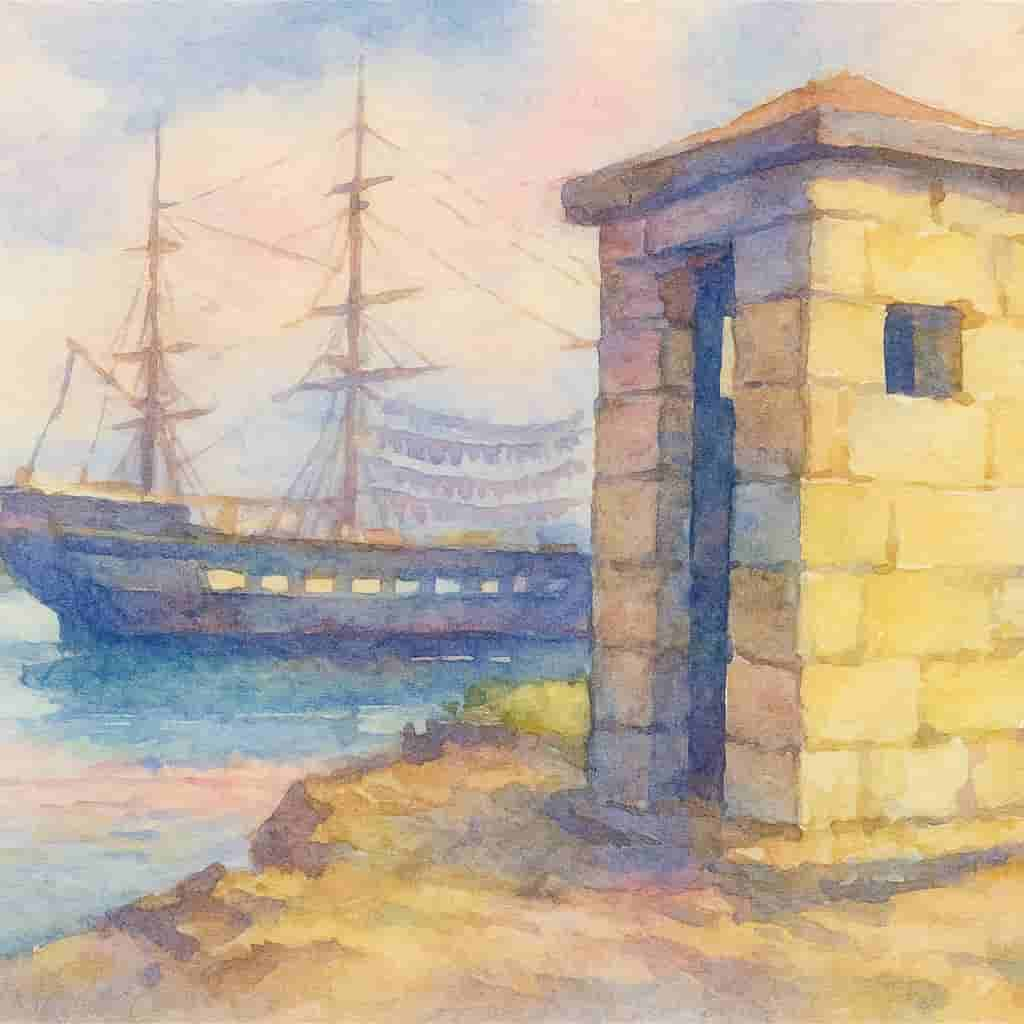
The penal establishment on Cockatoo Island was first sanctioned by Governor George Gipps over 180 years ago.
The reasons for Governor Gipps doing so are set out in correspondence to Lord Glenelg dated 13 May 1840 -
Image: AI created depiction of a Cockatoo Island Sentry Box from a sketch in Illustrated Sydney News 14 Nov 1889......
The Second Item, which I have authorised, is an Establishment on the Island called 'Cockatoo.' which is about four miles from Sydney situated in that branch of the Harbour which leads to Parramatta. I have caused an Establishment to be formed here for the reception of Prisoners withdrawn from Norfolk Island, order the Act passed in the last Session of the Legislature of the Colony which I had the honor to bring under Your Lordship's notice in my Despatch of the 26th Jany., 1839.
The expence of erecting shelter on Cockatoo Island for these men will not be greater than it would have been necessary to incur at Norfolk Island, if they had not been removed; for Norfolk Island was so full, that we could not in March last send another man there, so crowded was every building. By bringing them from Norfolk Island to Cockatoo, the duration of their sentences is reduced by more than one half, and they are more-over brought under the immediate eye of the Governor. All the Penal stations of this Colony, that is to say, stations for doubly convicted men, seem to me to have been erroneously placed at great distances from the seat of Government: Port Macquarie, Wellington Valley, Moreton Bay and Norfolk Island vary in distance from 200 to 800 miles; in consequence of which, they have rarely, if ever, been visited by the Governor of the Colony, or by any person high in authority, and it has been found successively to abandon them all except the latter.
Should it be desired to try the effect of any new system of management, as for instance that which has been proposed by Captain Maconochie, no place in New South Wales would be so well calculated for it as Cockatoo Island, surrounded as it is by deep water, and yet under the very eye of Authority. It is only a mile and a half beyond Goat Island, where the best conducted establishment in the Colony has been fixed for the last three or four years, but which we are now on the point of breaking up, as, by the completion of the Powder Magazine on it, it is no longer a desirable place for a large body of Convicts, and is also too small conveniently to accommodate them. Cockatoo Island affords very excellent Building Stone, and it may be ultimately made to supply this material to Sydney in the same way that the Penitentiary at Sing Sing supplies Building Stone to New York.
I have, etc., Geo. Gipps
Cockatoo Island was constituted by proclamation, the penal establishment of New South Wales on 7 June 1841.
Convict Labour
The convicts who were first deported to the Island were occupied in quarrying stone for the necessary buildings and also in constructing with the ballast, an extensive wharf at the eastern extremity of the island. Wherever it was possible a similar level was projected so that a sentry box could be placed at intervals around the circumference of the Island.All the original buildings on the site were constructed by convict labour - Cells for punishment, barracks for the guards and residences for various officials were made from sandstone hewn from the island.
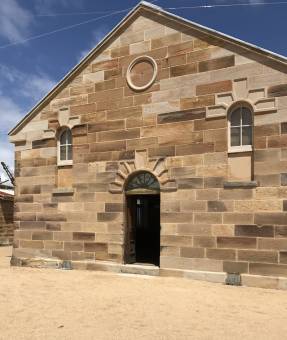 Convict Barracks
Convict Barracks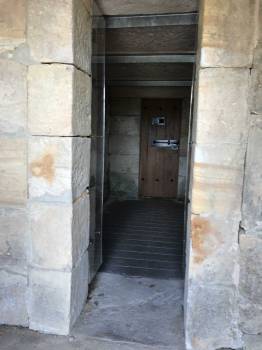 Cockatoo Island Prison Cells
Cockatoo Island Prison Cells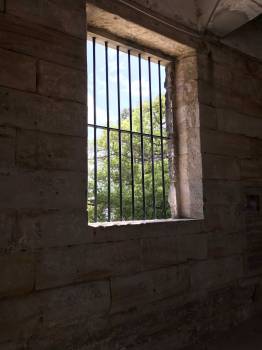
Convict Punishment
Many hundreds of convicts passed through the barracks at Cockatoo Island. Their lives while there were of unending toil. In the morning were awakened by the sound of a bell and their tools for the day issued to them. They then went to their allotted tasks which were overseen by a task master or ganger. Those who misbehaved were sent to the dark underground cells pictured above.They had few chances of making money for themselves although it was well known that they could earn a little extra to purchase tea and sugar by making Cabbage Tree Hats.
Grain Silos
Also built from convict labour were a set of silos for storing grain. The colony suffered shortages of grain and these were built to store grain thereby avoiding future food shortages. The silos were designed by Captain George Barney of the Royal Engineers and each of the twenty were shaped like a large bottle; they were about 7 metres wide and six metres deep.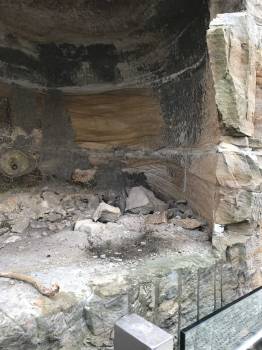 Remains of the grain silos
Remains of the grain silosHaving been used as a prison for twice convicted men for many years, an order dated 2 April 1856 directed that from that time forward Cockatoo Island should be the destination of all prisoners sentenced to work on the roads and other public works of the colony. Under this directive some of the states most notorious bushrangers came to be held there, the best known being Frederick Ward, alias Captain Thunderbolt who was one of the few if not the only to have made his escape from the Island; and Frank Gardiner alias Christie alias Francis Clarke, a native born lad who was arrested at Apis Creek, Queensland in 1864 for his part in the great gold escort robbery at Engowra in 1862.
Image: Frank Gardiner......
Frank Gardiner was sentenced to 32 years hard labour, however after petitions and guarantees by respectable settlers he came to be released after only a few years. Later he left the colony and sailed to San Francisco where it is said he opened a drinking saloon.
Biloela
In 1872 Cockatoo Island was abandoned as a prison and its name changed to Biloela. It was then used as an industrial school for destitute girls until 1888.From 1888 to 1908 it was a prison for petty offenders, vagrants and prostitutes. In addition, a training ship for delinquent and orphan boys - the Vernon, followed by the Sobraon - was moored at the island between 1871 and 1911.
Fitzroy Dock
In 1845 Governor Sir George Gipps, recommended to the British Government that a dry dock be constructed using convict labour to service visiting vessels of the Royal Navy. In 1847 the NSW Legislative Council approved the plan, and construction of Fitzroy Dock commenced in 1851.[5]Convicts Sent to Cockatoo Island
Some of the convicts incarcerated at Cockatoo Island in the early years:Thomas Ahern arrived on the Edward in 1831. Sent to Cockatoo Island in 1844
John Atkins, per Dick, bushranger, sentenced to 15 years penal servitude. Transferred to Cockatoo Island in October 1842
Thomas Barlow arrived free on the Royal Consort in 1840. He was sentenced to 5 years on the roads for a colonial crime and sent to Cockatoo Island in February 1855
Thomas Balkin per Royal Sovereign 1835 sent in March 1842
John Batchelor per Lady Feversham sent in April 1845 under sentence of 2 years in irons
Thomas Boulton per Nithsdale was sent to Cockatoo Island for disobedience
Andrew Bracken per Boyne was sent to Cockatoo Island in 1854
John Brelsford per Albion 1827
William Broadhurst per Mellish 1829
John Buckley per Hive 1835 sent in March 1841
Lawrence Cleary of Jacob's Irish Brigade sent in 1844
Thomas Divine per Forth 1830 sentenced to 12 months
Robert Dolman per John Barry 1839 sent in July 1842
Thomas Oldmeadow Fry, arrived per Mangles in 1833. He became a bushranger and was captured at Jerrys Plains. He was sent to the Island in 1846
Charles Grey, per Forth 1835, a shipmaster from Boston America was sent to Cockatoo Island for a colonial crime
Martin Hall per Marquis of Hastings 1828
Peter Hallam per Lord Lyndoch sent in August 1842
John Hughes per John Barry 1839
Thomas Humphries per Roslin Castle 1833
James Jackson per Lady Nugent sent in April 1844
James Kent per Bussorah Merchant. Sent for his conduct during a bushranger raid 1840
James Leeson per Bussorah Merchant 1831
William Law/Low who arrived as a convict on the Strathfieldsaye was sentenced to 15 years transportation at Cockatoo Island in 1845 after he was found guilty of robbing the Crown and Anchor Inn at New Freugh.
Francis Macnamara (Frank the Poet) June 1842
Matthew Mariner per Asia 1832. Sent in 1842
Timothy May alias Bergan per Forth 1835 was sent to Cockatoo Island for security
James Milward per Layton sent for a colonial crime
George Mitchell per Norfolk 1829. Removed from Cockatoo to the Hospital at Parramatta in 1859
William Oates arrived on the Marquis of Huntley in 1826 later sent to Cockatoo Island
John Quigley arrived on the Calcutta in 1837. He was sent to Cockatoo Island in April 1843 for bushranging
Eugene Quinn per Minerva 1819, a clerk from Cork was sent in October 1841. He died on Cockatoo Island
John Roach per Mangles 1833 bushranger sentenced to 15 years penal servitude. Transferred to Cockatoo Island in October 1842.
Samuel Rogers per John 1829 sent for a colonial crime
Samuel Rowney arrived on the John in 1832 when he was only 13 years of age. He was sent to Cockatoo Island in 1844
Toby (Aboriginal) Died on Cockatoo Island in 1842 from inflammation of the lungs and dysentery
William Seymour arrived per Portsea, sent to Cockatoo Island for his conduct during a bushranger raid 1840
Bryan Shea per Royal Admiral 1830 sent in 1844
Joseph Smith per Mangles 1828
Tallboy alias Jackey - The sentence of death passed on Tallboy alias Jackey for murder commuted to transportation to Cockatoo Island for life September 1840
John Townsend per Roslin Castle 1834. Sent in 1844
Charles Vout per Andromeda 1833. Sent in November 1841
Charles Whalley arrived on the Marquis of Huntley in 1826 later sent to Cockatoo Island
Three men were sent direct from the Havering in 1849 at the recommendation of the Surgeon, they having been ill behaved on the voyage out
Three men sent direct from the Adelaide in 1849 at the recommendation of the Surgeon
Cockatoo Island 1850 to 1859 -
Rev. Phillip P. Agnew - Chaplain Penal Establishment
John George Balls - Task work Clerk, Penal Establishment and Dry Dock
Henry Broderick - Foreman Engineer, Dry Dock
Jeremiah Brown - Assistant Superintendent, Penal Establishment
William Cahill - Foreman of Works, Dry Dock
John Duff - Clerk to Civil Engineer, Dry Dock
Thomas Easton - Foreman of Works, Dry Dock
Henry Fitzgerald - Foreman of Works, Dry Dock
David Forbes - Visiting Magistrate, Penal Establishment
Rev. Austin Forde - Roman Catholic Chaplain, Penal Establishment
Hugh Jones - Engineer Mechanic, Dry Dock
John Kelleher - Foreman of Works, Dry Dock
Alexander McDonnell - Dispenser, Penal Establishment
Gother Kerr Mann - Engineer-in-Chief, Dry Dock; Superintendent of Penal Establishment
Samuel North - Acting Visiting Magistrate
Charles Ormsby - Superintendent
Andrew S. Rogers - Clerk and Draftsman, Dry Dock
John Taylor - Clerk and Clerk of Petty Sessions, Penal Establishment
William Walsh - Dispenser, Penal Establishment
George West - Visiting Surgeon, Penal Establishment
Statistical Register of New South Wales
Notes and Links
[1] Correspondence to Lord Glenelg, 8 July 1839, Historical Records of Australia, Series 1, Vol. XX, p.217[2] Memorandum of the number and capacity of the Silos were excavated out of the Sandstone Rock at Cockatoo Island - Sydney Herald 24 February 1842
[3] Sketch Map of Cockatoo Island by James William Thomas, Resident Engineer of Cockatoo Island Sydney Illustrated News 17 June 1854
[4] Parramatta Past and Present - Illustrated Sydney News 14 November 1889
[6] Department of Environment and Energy
[7] Entrance Books for the Vernon and the Sobraon 1867-1911 - Ancestry
↑
